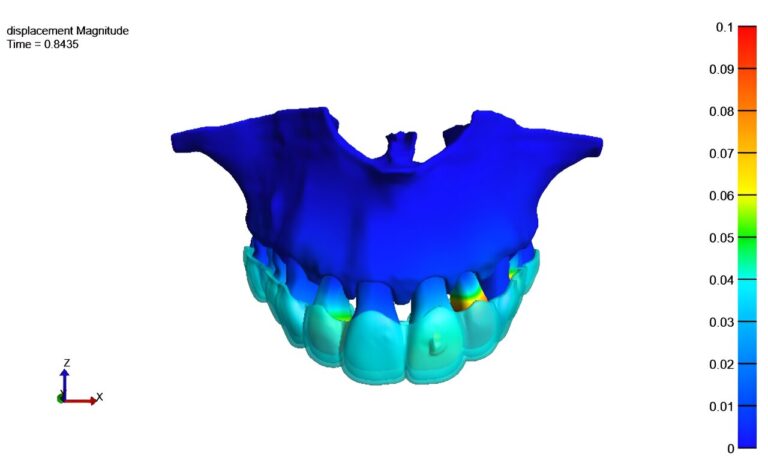A digital twin of a patient’s jaw created through the integration of artificial intelligence and computational modeling solutions, allowing the exact simulation of expected tooth movements under specific conditions. The color map visually represents the extent and direction of tooth movement, with warmer colors indicating higher tooth movements. Credit: University of Copenhagen
A new tool being developed by the University of Copenhagen and 3Shape will help orthodontists correctly fit braces to teeth. Using artificial intelligence and virtual patients, the tool predicts how teeth will move to ensure braces are neither too loose nor too tight.
Many of us remember the feeling of regularly adjusting and retightening our nails at the orthodontist’s office. And every year, about 30 percent of Danish youth up to the age of 15 wear braces to straighten crooked teeth. Orthodontists use the knowledge gained from their training and experience to perform their tasks, but without the capabilities that a computer can provide to predict the end results.
A new tool, developed in collaboration between the University of Copenhagen’s Department of Computer Science and the company 3Shape, makes it possible to simulate how braces should be applied to give the best result without too much unnecessary discomfort.
The tool was developed using scanned images of teeth and bone structures from human jaws, which AI then uses to predict how sets of braces should be designed to best straighten the patient’s teeth.
“Our simulation is able to inform an orthodontist where braces should and should not apply pressure to straighten teeth.”
“Currently, these interventions are entirely at the discretion of orthodontists and involve a lot of trial and error. This can lead to many adjustments and visits to the orthodontist’s office, which our simulation can help reduce in the long term,” says Professor Kenny Erleben, who heads IMAGE (Image Analysis, Computational Modeling, and Geometry), a research division in UCPH’s Department of Computer Science.
Helps predict tooth movement
It’s no wonder that it can be difficult to predict exactly how braces will move teeth because teeth continue to change slightly throughout a person’s life. And, these movements are very different from mouth to mouth.
“The fact that tooth movements vary from patient to patient makes it even more difficult to predict how teeth will move for different people accurately. That’s why we’ve developed a new tool and a dataset of different models to overcome these challenges,” explains Torkan Gholamalizadeh, from 3Shape and Ph.D. from the Department of Computer Science.
As an alternative to the classic brace and braces, a new generation of transparent braces, known as aligners, has gained ground. Aligners are designed as a clear plastic mold of teeth that patients fit over their teeth.
Patients must wear aligners for at least 22 hours a day and must be replaced with new, tighter sets every two weeks. Because aligners are made of plastic, a person’s teeth also change the contours of the aligner itself, which the new tool also takes into account.
“As clear aligners are softer than metal braces, calculating the force required to move the teeth becomes even more complicated. But it’s a factor we’ve taught our model to take into account so that one can predict the tooth movements when using aligners as well,” says Gholamalizadeh.
Digital twins can improve therapy
Researchers have created a computer model that creates accurate 3D simulations of a patient’s jaw that dentists and technicians can use to plan the best possible treatment.
To create these simulations, the researchers mapped sets of human teeth using detailed CT scans of teeth and the small, thin structures between the jawbone and teeth known as periodontal ligaments—a type of fiber-rich connective tissue that holds teeth in place in the jaw.
This type of exact digital imitation is referred to as a digital twin — and with this in mind, the researchers created a database of “digital dental patients.”
But they didn’t stop there. The researchers’ database also contains other digital patient types that could one day be used elsewhere in healthcare.
“Right now, we have a digital patient database that, in addition to simulating alignment designs, can be used for hip implants, among other things. In the long run, this could make patients’ lives easier and save resources for society,” says Kenny Erleben.
The field of research using digital twins is relatively new, and currently Professor Erleben’s database of virtual patients is a world leader. However, the database will need to become even larger if digital twins are to truly take root and benefit the healthcare sector and society.
“More data will allow us to simulate treatments and tailor medical devices to target patients in entire populations more precisely,” says Professor Erleben.
In addition, the tool must overcome several regulatory hurdles before it can be released to orthodontists. This is something researchers hope to see in the near future.
The findings are published in the magazine Access IEEE.
More information:
Peidi Xu et al, Deep-learning-based Segmentation of Individual Tooth and Bone with Periodontal Ligament Interface Details for Simulation Purposes, Access IEEE (2023). DOI: 10.1109/ACCESS.2023.3317512
Reference: Straightening teeth? AI Can Help (2024, 13 March) retrieved 17 March 2024 from
This document is subject to copyright. Except for any fair dealing for purposes of private study or research, no part may be reproduced without written permission. Content is provided for informational purposes only.


